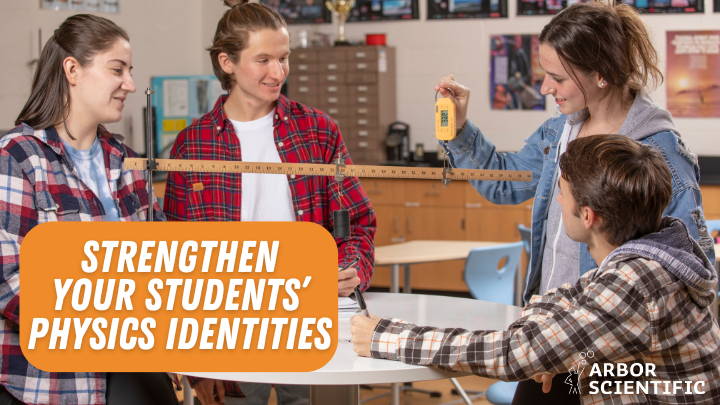A Guide To Help Every Student Be A "Physics Person"
If you ask a teacher why they went into teaching, you’ll get answers that range from the idyllic “I wanted to make a difference,” to the sarcastic, “I wanted summers off.” Yet, most of us couldn't persist in the field of education without a stubborn sense of hope, even if it occasionally wanes. Sometimes it seems like progress is slow, but small changes do add up to big differences in our classrooms and schools. Every little bit can help when it comes to supporting students, especially those who have been historically excluded from physics.
The STEP UP Program’s curriculum, two lessons and an Everyday Actions Guide, are research based tools for educators to incorporate into their pedagogy to support women and other underrepresented groups in pursuing physics. The Everyday Actions Guide includes suggestions for positive changes the teachers can make in their classroom, ways to work with other school staff, strategies for organizing groups of students, and more. The Guide is organized into five categories of actions and strategies for reducing marginalization in the classroom and recognizing all students as physics people:
We’re lucky in science that hands-on experiments create lots of opportunities for students to work together and for the teacher to check on students in groups and individually. When we walk around to check progress it's a chance to recognize students for their thinking and encourage them in their efforts. In physics especially, studies have shown that the recognition by their high school physics teachers has a strong correlation with female students persisting in physics and feeling like a “physics person”. (Hazari, et al, 2017)
While students work in groups, not every student has the confidence to try using equipment they are unfamiliar with. Stronger personalities may not give equal speaking time to their peers, and make some students feel unwelcome in physics. Scaffolding predetermined group roles can help students develop confidence with skills they may not have gravitated towards on their own. All skills used in hands-on science experiments (manipulating equipment, making measurements, collecting data, and analyzing it) are important and should be experienced by each student. Just as important, but not as often discretely taught, are the “soft skills” of collaboration and teamwork. Whatever their future careers, our students will interact with other individuals all day, and they will need to work through interpersonal difficulties.
Little opportunities to feature a student as an “expert” can come up randomly. Thus, it is important for the teacher to use these opportunities to spotlight female or other marginalized students in our classroom. For example, while using the Constant Velocity Cars, groups in later periods frequently ask to change out the batteries. I’ll call one of the female members of the group over to show her where the screwdriver and the batteries are kept; since the lab is fairly early in the year students won’t know where all our classroom equipment is yet. When the next group asks how to change the batteries, I can refer them to the first student I showed, who is now our expert “car mechanic” and can share the knowledge.
Sometimes our favorite physics examples can be difficult to understand if you have not experienced them yourself. Teachers have to understand and respect the fact that our students come into our classrooms with different lived experiences. Creating common experiences within physics means that I know I can refer back to those activities and each student will have equal footing. Having enough equipment for each student to do a simple experiment can make all the difference for student-to-student discussions and sensemaking. I used to have only a few of the Happy Unhappy Ball sets for demonstrations but last year decided to buy enough for each pair of students to experiment with at the same time. This allowed every student to conduct the experiment, and no one could be a spectator. As a result, the conversations about the activity got deeper, and the discussions were more engaging as the students were each talking about this shared experience.
Ready to make some changes in your classroom? Try taking the self-reflection quiz from the Everyday Actions Guide to think about what you already do. No one is checking your answers, and we recognize not everything is possible in every educational setting. As you reflect on your selections and think about what next steps you can take, remember that a little bit every day makes a big difference in how your students feel, learn and interact with each other in your classroom. You may have done some of these actions only once or twice, like telling one of your female students that she is great in physics and should consider studying it in college. However, we want you to practice these strategies consistently in your classroom, making strengthening your students’ physics identity a habit. Hence, the name “Everyday Actions”.
Learn more about both lessons on our website, www.STEPUPphysics.org/curriculum. You can also join the STEP UP online community, made up of educators and allies from every level, to learn more about how to teach the lessons and adapt them for your classrooms.
This work is supported by the National Science Foundation under Grant Nos. 2300607,1720810, 1720869, 1720917, and 1721021 and the Gordon & Betty Moore Foundation DOI: doi.org/10.37807/GBMF11451
References
Hazari, Z., Brewe, E., Goertzen, R. M., & Hodapp, T. (2017). The Importance of High School Physics Teachers for Female Students’ Physics Identity and Persistence. The Physics Teacher, 55(2), 96-99. https://doi.org/10.1119/1.4974122
About the author
Bree Barnett Dreyfuss has been teaching Physics and AP Physics at Amador Valley High School for almost 20 years. She has been involved with the STEP UP program since 2018, helping to increase the number of undergraduate women in physics and supporting inclusivity in high school physics classrooms.
Looking for more CoolStuff?
Check out the Education Center for past CoolStuff articles that provide free resources, how-to videos, and teacher-written articles like this one.


